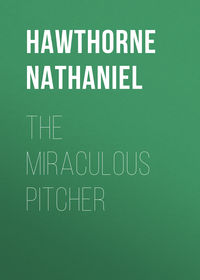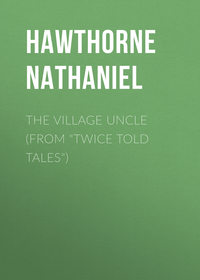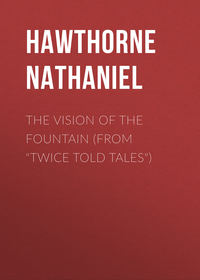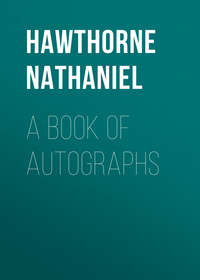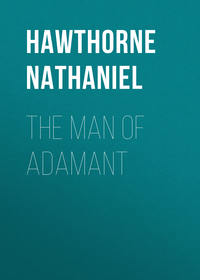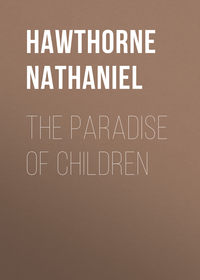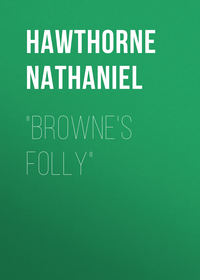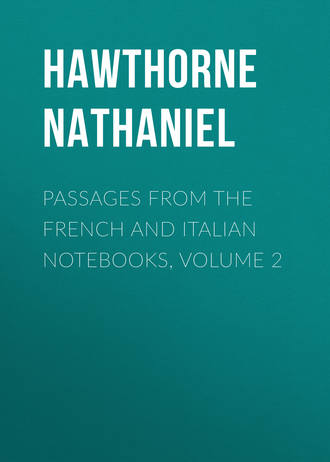 полная версия
полная версияPassages from the French and Italian Notebooks, Volume 2
As one instance of the little influence the religion of the Italians has upon their morals, he told a story of one of his servants, who desired leave to set up a small shrine of the Virgin in their room – a cheap print, or bas-relief, or image, such as are sold everywhere at the shops – and to burn a lamp before it; she engaging, of course, to supply the oil at her own expense. By and by, her oil-flask appeared to possess a miraculous property of replenishing itself, and Mr. Powers took measures to ascertain where the oil came from. It turned out that the servant had all the time been stealing the oil from them, and keeping up her daily sacrifice and worship to the Virgin by this constant theft.
His talk soon turned upon sculpture, and he spoke once more of the difficulty imposed upon an artist by the necessity of clothing portrait statues in the modern costume. I find that he does not approve either of nudity or of the Roman toga for a modern statue; neither does he think it right to shirk the difficulty – as Chantrey did in the case of Washington – by enveloping him in a cloak; but acknowledges the propriety of taking the actual costume of the age and doing his best with it. He himself did so with his own Washington, and also with a statue that he made of Daniel Webster. I suggested that though this costume might not appear ridiculous to us now, yet, two or three centuries hence, it would create, to the people of that day, an impossibility of seeing the real man through the absurdity of his envelopment, after it shall have entirely grown out of fashion and remembrance; and Webster would seem as absurd to them then as he would to us now in the masquerade of some bygone day. It might be well, therefore, to adopt some conventional costume, never actual, but always graceful and noble. Besides, Webster, for example, had other costumes than that which he wore in public, and perhaps it was in those that he lived his most real life; his dressing-gown, his drapery of the night, the dress that he wore on his fishing-excursions; in these other costumes he spent three fourths of his time, and most probably was thus arrayed when he conceived the great thoughts that afterwards, in some formal and outside mood, he gave forth to the public. I scarcely think I was right, but am not sure of the contrary. At any rate, I know that I should have felt much more sure that I knew the real Webster, if I had seen him in any of the above-mentioned dresses, than either in his swallow-tailed coat or frock.
Talking of a taste for painting and sculpture, Powers observed that it was something very different and quite apart from the moral sense, and that it was often, perhaps generally, possessed by unprincipled men of ability and cultivation. I have had this perception myself. A genuine love of painting and sculpture, and perhaps of music, seems often to have distinguished men capable of every social crime, and to have formed a fine and hard enamel over their characters. Perhaps it is because such tastes are artificial, the product of cultivation, and, when highly developed, imply a great remove from natural simplicity.
This morning I went with U – to the Uffizi gallery, and again looked with more or less attention at almost every picture and statue. I saw a little picture of the golden age, by Zucchero, in which the charms of youths and virgins are depicted with a freedom that this iron age can hardly bear to look at. The cabinet of gems happened to be open for the admission of a privileged party, and we likewise went in and saw a brilliant collection of goldsmiths' work, among which, no doubt, were specimens from such hands as Benvenuto Cellini. Little busts with diamond eyes; boxes of gems; cups carved out of precious material; crystal vases, beautifully chased and engraved, and sparkling with jewels; great pearls, in the midst of rubies; opals, rich with all manner of lovely lights. I remember Benvenuto Cellini, in his memoirs, speaks of manufacturing such playthings as these.
I observed another characteristic of the summer streets of Florence to-day; tables, movable to and fro, on wheels, and set out with cool iced drinks and cordials.
June 17th. – My wife and I went, this morning, to the Academy of Fine Arts, and, on our way thither, went into the Duomo, where we found a deliciously cool twilight, through which shone the mild gleam of the painted windows. I cannot but think it a pity that St. Peter's is not lighted by such windows as these, although I by no means saw the glory in them now that I have spoken of in a record of my former visit. We found out the monument of Giotto, a tablet, and portrait in bas-relief, on the wall, near the entrance of the cathedral, on the right hand; also a representation, in fresco, of a knight on horseback, the memorial of one John Rawkwood, close by the door, to the left. The priests were chanting a service of some kind or other in the choir, terribly inharmonious, and out of tune..
On reaching the Academy, the soldier or policeman at the entrance directed us into the large hall, the walls of which were covered on both sides with pictures, arranged as nearly as possible in a progressive series, with reference to the date of the painters; so that here the origin and procession of the art may be traced through the course of, at least, two hundred years. Giotto, Cimabue, and others of unfamiliar names to me, are among the earliest; and, except as curiosities, I should never desire to look once at them, nor think of looking twice. They seem to have been executed with great care and conscientiousness, and the heads are often wrought out with minuteness and fidelity, and have so much expression that they tell their own story clearly enough; but it seems not to have been the painter's aim to effect a lifelike illusion, the background and accessories being conventional. The trees are no more like real trees than the feather of a pen, and there is no perspective, the figure of the picture being shadowed forth on a surface of burnished gold. The effect, when these pictures, some of them very large, were new and freshly gilded, must have been exceedingly brilliant, and much resembling, on an immensely larger scale, the rich illuminations in an old monkish missal. In fact, we have not now, in pictorial ornament, anything at all comparable to what their splendor must have been. I was most struck with a picture, by Fabriana Gentile, of the Adoration of the Magi, where the faces and figures have a great deal of life and action, and even grace, and where the jewelled crowns, the rich embroidered robes, and cloth of gold, and all the magnificence of the three kings, are represented with the vividness of the real thing: a gold sword-hilt, for instance, or a pair of gold spurs, being actually embossed on the picture. The effect is very powerful, and though produced in what modern painters would pronounce an unjustifiable way, there is yet pictorial art enough to reconcile it to the spectator's mind. Certainly, the people of the Middle Ages knew better than ourselves what is magnificence, and how to produce it; and what a glorious work must that have been, both in its mere sheen of burnished gold, and in its illuminating art, which shines thus through the gloom of perhaps four centuries.
Fra Angelico is a man much admired by those who have a taste for Pre-Raphaelite painters; and, though I take little or no pleasure in his works, I can see that there is great delicacy of execution in his heads, and that generally he produces such a Christ, and such a Virgin, and such saints, as he could not have foreseen, except in a pure and holy imagination, nor have wrought out without saying a prayer between every two touches of his brush. I might come to like him, in time, if I thought it worth while; but it is enough to have an outside perception of his kind and degree of merit, and so to let him pass into the garret of oblivion, where many things as good, or better, are piled away, that our own age may not stumble over them. Perugino is the first painter whose works seem really worth preserving for the genuine merit that is in them, apart from any quaintness and curiosity of an ancient and new-born art. Probably his religion was more genuine than Raphael's, and therefore the Virgin often revealed herself to him in a loftier and sweeter face of divine womanhood than all the genius of Raphael could produce. There is a Crucifixion by him in this gallery, which made me partly feel as if I were a far-off spectator, – no, I did not mean a Crucifixion, but a picture of Christ dead, lying, with a calm, sweet face, on his mother's knees ["a Pieta"].
The most inadequate and utterly absurd picture here, or in any other gallery, is a head of the Eternal Father, by Carlo Dolce; it looks like a feeble saint, on the eve of martyrdom, and very doubtful how he shall be able to bear it; very finely and prettily painted, nevertheless.
After getting through the principal gallery we went into a smaller room, in which are contained a great many small specimens of the old Tuscan artists, among whom Fra Angelico makes the principal figure. These pictures are all on wood, and seem to have been taken from the shrines and altars of ancient churches; they are predellas and triptychs, or pictures on three folding tablets, shaped quaintly, in Gothic peaks or arches, and still gleaming with backgrounds of antique gold. The wood is much worm-eaten, and the colors have often faded or changed from what the old artists meant then to be; a bright angel darkening into what looks quite as much like the Devil. In one of Fra Angelico's pictures, – a representation of the Last Judgment, – he has tried his saintly hand at making devils indeed, and showing them busily at work, tormenting the poor, damned souls in fifty ghastly ways. Above sits Jesus, with the throng of blessed saints around him, and a flow of tender and powerful love in his own face, that ought to suffice to redeem all the damned, and convert the very fiends, and quench the fires of hell. At any rate, Fra Angelico had a higher conception of his Saviour than Michael Angelo.
June 19th. – This forenoon we have been to the Church of St. Lorenzo, which stands on the site of an ancient basilica, and was itself built more than four centuries ago. The facade is still an ugly height of rough brickwork, as is the case with the Duomo, and, I think, some other churches in Florence; the design of giving them an elaborate and beautiful finish having been delayed from cycle to cycle, till at length the day for spending mines of wealth on churches is gone by. The interior had a nave with a flat roof, divided from the side aisles by Corinthian pillars, and, at the farther end, a raised space around the high altar. The pavement is a mosaic of squares of black and white marble, the squares meeting one another cornerwise; the pillars, pilasters, and other architectural material is dark brown or grayish stone; and the general effect is very sombre, especially as the church is somewhat dimly lighted, and as the shrines along the aisles, and the statues, and the monuments of whatever kind, look dingy with time and neglect. The nave is thickly set with wooden seats, brown and worn. What pictures there are, in the shrines and chapels, are dark and faded. On the whole, the edifice has a shabby aspect. On each side of the high altar, elevated on four pillars of beautiful marble, is what looks like a great sarcophagus of bronze. They are, in fact, pulpits, and are ornamented with mediaeval bas-reliefs, representing scenes in the life of our Saviour. Murray says that the resting-place of the first Cosmo de' Medici, the old banker, who so managed his wealth as to get the posthumous title of "father of his country," and to make his posterity its reigning princes, – is in front of the high altar, marked by red and green porphyry and marble, inlaid into the pavement. We looked, but could not see it there.
There were worshippers at some of the shrines, and persons sitting here and there along the nave, and in the aisles, rapt in devotional thought, doubtless, and sheltering themselves here from the white sunshine of the piazzas. In the vicinity of the choir and the high altar, workmen were busy repairing the church, or perhaps only making arrangements for celebrating the great festival of St. John.
On the left hand of the choir is what is called the old sacristy, with the peculiarities or notabilities of which I am not acquainted. On the right hand is the new sacristy, otherwise called the Capella dei Depositi, or Chapel of the Buried, built by Michael Angelo, to contain two monuments of the Medici family. The interior is of somewhat severe and classic architecture, the walls and pilasters being of dark stone, and surmounted by a dome, beneath which is a row of windows, quite round the building, throwing their light down far beneath, upon niches of white marble. These niches are ranged entirely around the chapel, and might have sufficed to contain more than all the Medici monuments that the world would ever care to have. Only two of these niches are filled, however. In one of them sits Giuliano de' Medici, sculptured by Michael Angelo, – a figure of dignity, which would perhaps be very striking in any other presence than that of the statue which occupies the corresponding niche. At the feet of Giuliano recline two allegorical statues, Day and Night, whose meaning there I do not know, and perhaps Michael Angelo knew as little. As the great sculptor's statues are apt to do, they fling their limbs abroad with adventurous freedom. Below the corresponding niche, on the opposite side of the chapel, recline two similar statues, representing Morning and Evening, sufficiently like Day and Night to be their brother and sister; all, in truth, having sprung from the same father..
But the statue that sits above these two latter allegories, Morning and Evening, is like no other that ever came from a sculptor's hand. It is the one work worthy of Michael Angelo's reputation, and grand enough to vindicate for him all the genius that the world gave him credit for. And yet it seems a simple thing enough to think of or to execute; merely a sitting figure, the face partly overshadowed by a helmet, one hand supporting the chin, the other resting on the thigh. But after looking at it a little while the spectator ceases to think of it as a marble statue; it comes to life, and you see that the princely figure is brooding over some great design, which, when he has arranged in his own mind, the world will be fain to execute for him. No such grandeur and majesty has elsewhere been put into human shape. It is all a miracle; the deep repose, and the deep life within it. It is as much a miracle to have achieved this as to make a statue that would rise up and walk. The face, when one gazes earnestly into it, beneath the shadow of its helmet, is seen to be calmly sombre; a mood which, I think, is generally that of the rulers of mankind, except in moments of vivid action. This statue is one of the things which I look at with highest enjoyment, but also with grief and impatience, because I feel that I do not come at all which it involves, and that by and by I must go away and leave it forever. How wonderful! To take a block of marble, and convert it wholly into thought, and to do it through all the obstructions and impediments of drapery; for there is nothing nude in this statue but the face and hands. The vest is the costume of Michael Angelo's century. This is what I always thought a sculptor of true genius should be able to do, – to show the man of whatever epoch, nobly and heroically, through the costume which he might actually have worn.
The statue sits within a square niche of white marble, and completely fills it. It seems to me a pity that it should be thus confined. At the Crystal Palace, if I remember, the effect is improved by a free surrounding space. Its naturalness is as if it came out of the marble of its own accord, with all its grandeur hanging heavily about it, and sat down there beneath its weight. I cannot describe it. It is like trying to stop the ghost of Hamlet's father, by crossing spears before it.
Communicating with the sacristy is the Medicean Chapel, which was built more than two centuries ago, for the reception of the Holy Sepulchre; arrangements having been made about that time to steal this most sacred relic from the Turks. The design failing, the chapel was converted by Cosmo II. into a place of sepulture for the princes of his family. It is a very grand and solemn edifice, octagonal in shape, with a lofty dome, within which is a series of brilliant frescos, painted not more than thirty years ago. These pictures are the only portion of the adornment of the chapel which interferes with the sombre beauty of the general effect; for though the walls are incrusted, from pavement to dome, with marbles of inestimable cost, and it is a Florentine mosaic on a grander scale than was ever executed elsewhere, the result is not gaudy, as in many of the Roman chapels, but a dark and melancholy richness. The architecture strikes me as extremely fine; each alternate side of the octagon being an arch, rising as high as the cornice of the lofty dome, and forming the frame of a vast niche. All the dead princes, no doubt, according to the general design, were to have been honored with statues within this stately mausoleum; but only two – those of Ferdinand I. and Cosmo II. – seem to have been placed here. They were a bad breed, and few of them deserved any better monument than a dunghill; and yet they have this grand chapel for the family at large, and yonder grand statue for one of its most worthless members. I am glad of it; and as for the statue, Michael Angelo wrought it through the efficacy of a kingly idea, which had no reference to the individual whose name it bears.
In the piazza adjoining the church is a statue of the first Cosmo, the old banker, in Roman costume, seated, and looking like a man fit to hold authority. No, I mistake; the statue is of John de' Medici, the father of Cosmo, and himself no banker, but a soldier.
June 21st. – Yesterday, after dinner, we went, with the two eldest children, to the Boboli Gardens… We entered by a gate, nearer to our house than that by the Pitti Palace, and found ourselves almost immediately among embowered walks of box and shrubbery, and little wildernesses of trees, with here and there a seat under an arbor, and a marble statue, gray with ancient weather-stains. The site of the garden is a very uneven surface, and the paths go upward and downward, and ascend, at their ultimate point, to a base of what appears to be a fortress, commanding the city. A good many of the Florentines were rambling about the gardens, like ourselves: little parties of school-boys; fathers and mothers, with their youthful progeny; young men in couples, looking closely into every female face; lovers, with a maid or two attendant on the young lady. All appeared to enjoy themselves, especially the children, dancing on the esplanades, or rolling down the slopes of the hills; and the loving pairs, whom it was rather embarrassing to come upon unexpectedly, sitting together on the stone seat of an arbor, with clasped hands, a passionate solemnity in the young man's face, and a downcast pleasure in the lady's. Policemen, in cocked hats and epaulets, cross-belts, and swords, were scattered about the grounds, but interfered with nobody, though they seemed to keep an eye on all. A sentinel stood in the hot sunshine, looking down over the garden from the ramparts of the fortress.
For my part, in this foreign country, I have no objection to policemen or any other minister of authority; though I remember, in America, I had an innate antipathy to constables, and always sided with the mob against law. This was very wrong and foolish, considering that I was one of the sovereigns; but a sovereign, or any number of sovereigns, or the twenty-millionth part of a sovereign, does not love to find himself, as an American must, included within the delegated authority of his own servants.
There is a sheet of water somewhere in the Boboli Gardens, inhabited by swans; but this we did not see. We found a smaller pond, however, set in marble, and surrounded by a parapet, and alive with a multitude of fish. There were minnows by the thousand, and a good many gold-fish; and J – , who had brought some bread to feed the swans, threw in handfuls of crumbs for the benefit of these finny people. They seemed to be accustomed to such courtesies on the part of visitors; and immediately the surface of the water was blackened, at the spot where each crumb fell, with shoals of minnows, thrusting one another even above the surface in their eagerness to snatch it. Within the depths of the pond, the yellowish-green water – its hue being precisely that of the Arno – would be reddened duskily with the larger bulk of two or three gold-fishes, who finally poked their great snouts up among the minnows, but generally missed the crumb. Beneath the circular margin of the pond, there are little arches, into the shelter of which the fish retire, when the noonday sun burns straight down into their dark waters. We went on through the garden-paths, shadowed quite across by the high walls of box, and reached an esplanade, whence we had a good view of Florence, with the bare brown ridges on the northern side of the Arno, and glimpses of the river itself, flowing like a street, between two rows of palaces. A great way off, too, we saw some of the cloud-like peaks of the Apennines, and, above them, the clouds into which the sun was descending, looking quite as substantial as the distant mountains. The city did not present a particularly splendid aspect, though its great Duomo was seen in the middle distance, sitting in its circle of little domes, with the tall campanile close by, and within one or two hundred yards of it, the high, cumbrous bulk of the Palazzo Vecchio, with its lofty, machicolated, and battlemented tower, very picturesque, yet looking exceedingly like a martin-box, on a pole. There were other domes and towers and spires, and here and there the distinct shape of an edifice; but the general picture was of a contiguity of red earthen roofs, filling a not very broad or extensive valley, among dry and ridgy hills, with a river-gleam lightening up the landscape a little. U – took out her pencil and tablets, and began to sketch the tower of the Palazzo Vecchio; in doing which, she immediately became an object of curiosity to some little boys and larger people, who failed not, under such pretences as taking a grasshopper off her dress, or no pretence at all, to come and look over her shoulder. There is a kind of familiarity among these Florentines, which is not meant to be discourteous, and ought to be taken in good part.
We continued to ramble through the gardens, in quest of a good spot from which to see the sunset, and at length found a stone bench, on the slope of a hill, whence the entire cloud and sun scenery was fully presented to us. At the foot of the hill were statues, and among them a Pegasus, with wings outspread; and, a little beyond, the garden-front of the Pitti Palace, which looks a little less like a state-prison here, than as it fronts the street. Girls and children, and young men and old, were taking their pleasure in our neighborhood; and, just before us, a lady stood talking with her maid. By and by, we discovered her to be Miss Howorth. There was a misty light, streaming down on the hither side of the ridge of hills, that was rather peculiar; but the most remarkable thing was the shape into which the clouds gathered themselves, after the disappearance of the sun. It was like a tree, with a broad and heavy mass of foliage, spreading high upward on the sky, and a dark and well-defined trunk, which rooted itself on the verge of the horizon.
This morning we went to the Pitti Palace. The air was very sultry, and the pavements, already heated with the sun, made the space between the buildings seem like a close room. The earth, I think, is too much stoned out of the streets of an Italian city, – paved, like those of Florence, quite across, with broad flagstones, to the line where the stones of the houses on each side are piled up. Thunder rumbled over our heads, however, and the clouds were so dark that we scarcely hoped to reach the palace without feeling the first drops of the shower. The air still darkened and darkened, so that by the time we arrived at the suite of picture-rooms the pictures seemed all to be changed to Rembrandts; the shadows as black as midnight, with only some highly illuminated portions gleaming out. The obscurity of the atmosphere made us sensible how splendid is the adornment of these saloons. For the gilded cornices shone out, as did the gilding of the arches and wreathed circles that divide the ceiling into compartments, within which the frescos are painted, and whence the figures looked dimly down, like gods out of a mysterious sky. The white marble sculptures also gleamed from their height, where winged cupids or cherubs gambolled aloft in bas-reliefs; or allegoric shapes reclined along the cornices, hardly noticed, when the daylight comes brightly into the window. On the walls, all the rich picture-frames glimmered in gold, as did the framework of the chairs, and the heavy gilded pedestals of the marble, alabaster, and mosaic tables. These are very magnificent saloons; and since I have begun to speak of their splendor, I may as well add that the doors are framed in polished, richly veined marble, and the walls hung with scarlet damask.




